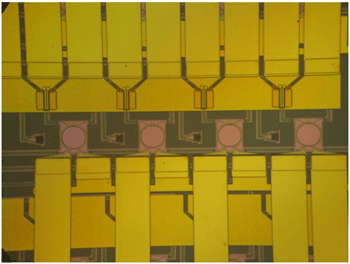- News
16 March 2012
EU’s BOOM project on SOI photonic integration completed
 Nanoelectronics research center Imec of Leuven, Belgium and its partners have completed ‘BOOM’, a project funded by the European Union (EU) and coordinated by the National Technical University of Athens (NTUA). By systematically advancing silicon-on-insulator (SOI) photonic integration technology, compact, cost-effective and power-efficient components have been developed that enable photonic Tb/s capacity systems for current- and new-generation high-speed broadband core networks, says Imec. As part of the project, Imec realized an optical label extractor consisting of a high-resolution demultiplexer integrated with highly efficient photodetectors.
Nanoelectronics research center Imec of Leuven, Belgium and its partners have completed ‘BOOM’, a project funded by the European Union (EU) and coordinated by the National Technical University of Athens (NTUA). By systematically advancing silicon-on-insulator (SOI) photonic integration technology, compact, cost-effective and power-efficient components have been developed that enable photonic Tb/s capacity systems for current- and new-generation high-speed broadband core networks, says Imec. As part of the project, Imec realized an optical label extractor consisting of a high-resolution demultiplexer integrated with highly efficient photodetectors.
Picture: Four-channel label extractor with four high-finesse ring resonators integrated with InGaAs photodetectors.
BOOM focused on the development of a photonic routing platform relying on hybrid SOI integrated photonic ICs to implement all the routing functionalities. These included label detection (Imec), control signal generation (Heinrich-Hertz-Institute HHI and IHP - Innovations for High-Performance Microelectronics), wavelength conversion (NTUA, Technische Universiteit Eindhoven TU/e, and Technische Universität Berlin) and wavelength routing (LioniX BV of Enschede, The Netherlands and AMO GmbH of Aachen, Germany). Finally, a routing machine with an aggregate capacity of >160Gb/s was built by NTUA and Telecom Italia Lab.
Imec says that, this way, the project has answered the growing demand for bandwidth-hungry Internet applications, which stresses the available capacity and performance of current optical core networks. Power efficiency, physical size and equipment cost are key issues in these networks and are increasingly more difficult to keep within acceptable limits, it notes. Electronic carrier routing systems consume and dissipate large amounts of electrical power and heat respectively. By incorporating photonics technologies deeper into these routers, their performance can be improved and power consumption decreased, Imec reckons.
Imec’s work within the project focused on the optical label detector. In the proposed routing architecture the optical data packets are labeled with a wavelength code, which has to be extracted from the packet and sent to the routing unit. The label extractor consists of an optical demultiplexer with very high resolution (12.5GHz) fabricated on Imec’s silicon photonics platform and integrated with high-efficiency indium gallium arsenide (InGaAs) photodetectors.
Reaching the required resolution turned out to be very challenging and required an in-depth study of silicon micro-ring resonators, says Imec. The required specifications could be reached using single ring resonator based filters. The ring resonators have integrated resistors which allow fine tuning of the wavelength channels (bottom electrodes) through the thermo-optic effect. They are connected to evanescently coupled InGaAs photodetectors using the heterogeneous integration technology developed by INTEC (Imec’s associated laboratory at Ghent University). The detectors had an efficiency of close to 1A/W and were operating at the specified speed of 1GB/s (up to 5GB/s). Finally the device was packaged in collaboration with Fraunhofer IZM group in Berlin, Germany. The device is now ready for operation in a system test-bed.
The results obtained by Imec in the project, and in particular the exhaustive study on the micro-ring resonators, are not only relevant for realizing the optical label extractor. They also form a key input for the Imec optical interconnect program, which requires high-performance demultiplexers for increasing the bandwidth in optical chip-to-chip links. Further, they can be used in optical sensors and non-linear devices, says Imec.
SOI photonic integration InGaAs photodetectors
